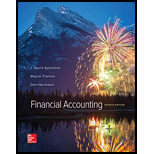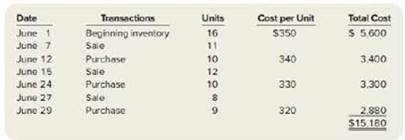
Concept explainers
Calculate ending inventory and cost of goods sold for four inventory methods (LO6–3)
PROBLEMS: SET B
Jimmie’s Fishing Hole has the following transactions related to its top-selling Shimano fishing reel for the month of June:

Requited:
1. Calculate ending inventory and cost of goods sold at June 30, using the specific identification method The June 7 sale consists of fishing reels from beginning inventory, the June 15 sale consists of three fishing reels from beginning inventory and nine fishing reels from the June 12 purchase, and the June 27 sale consists of one fishing reel from beginning inventory and seven fishing reels from the June 21 purchase.
2. Using FIFO, calculate ending inventory and cost of goods sold at June 30.
3. Using LIFO, calculate ending inventory arid cost of goods sold at June 30.
4. Using weighted average cost, calculate ending inventory and cost of goods sold at June 30.
1.
To Compute: The ending inventory and cost of goods sold using the specific identification method.
Explanation of Solution
Specific identification method:
Specific identification method is a method in which the company records each item of the inventory at its original cost. Under this method, when the goods are sold, the company can easily identify the original costs at which they were purchased for. This method helps in arriving at the accurate cost of goods sold, and ending inventory.
Calculate the units of ending inventory.
|
Calculation of Ending Inventory | |||
| Details | Number of Units | Rate Per Unit ($) | Total Cost ($) |
| Beginning balance | 16 | ||
| Less: Sales – June 7 | (11) | ||
| Less: sales– June 15 | (3) | ||
| Less: Sales –June 27 | (1) | ||
| Balance | 1 | 350 | 350 |
| Purchases: | |||
| June 12 | 10 | ||
| Less: Sales – June 15 | (9) | ||
| Balance | 1 | 340 | 340 |
| Purchases: | |||
| June 24 | 10 | ||
| Less: October 28 | (7) | - | |
|
Balance |
3 |
330 | 990 |
|
June 29 |
9 |
320 |
2,880 |
|
Ending Inventory |
14 | 45,650 | |
Table (1)
Therefore, the cost of Ending Inventory in specific identification method is $45,650.
Calculate the cost of goods sold:
| Calculation of Cost of Goods Sold | |||
| Details | Number of Units | Rate Per Unit ($) | Total Cost ($) |
| June 1: Beginning balance | 11 | 350 | 3,850 |
| June 1: Beginning balance | 3 | 350 | 1,050 |
| June 12: Purchase | 9 | 340 | 3,060 |
| June 1: Beginning balance | 1 | 350 | 350 |
| June 24: Purchase | 7 | 330 | 2,310 |
| Cost of Goods Sold | 31 | 10,620 | |
Table (2)
Therefore, the Cost of Goods Sold in specific identification method is $10,620.
2.
To Compute: The ending inventory and cost of goods sold using the FIFO method.
Explanation of Solution
First-in-First-Out:
In First-in-First-Out method, the costs of the initially purchased items are considered as cost of goods sold, for the items which are sold first. The value of the ending inventory consists of the recent purchased items.
Calculate the total Cost and units of Goods Available for Sales.
| Calculation of Goods Available for Sales | |||
| Details | Number of Units | Rate per unit ($) | Total Cost ($) |
| Beginning balance | 16 | 350 | 5,600 |
| Add: Purchases | |||
| June 12 | 10 | 340 | 3,400 |
| June 24 | 10 | 330 | 3,300 |
| June 29 | 9 | 320 | 2,880 |
|
Total Goods available for Sale |
45 |
15,180 | |
Table (3)
Calculate the units of ending inventory.
| Calculation of Ending Inventory (Units) | ||
| Details | Number of Units | Number of Units |
| Beginning balance | 16 | |
| Add: Purchases | ||
| June 12 | 10 | |
| June 24 | 10 | |
| June 29 | 9 | |
| Total Goods available for Sale | 45 | |
| Less: Sales | ||
| June 7 | 11 | |
| June 15 | 12 | |
| June 27 | 8 | |
| Total Sales | (31) | |
| Ending Inventory | 14 | |
Table (4)
Calculate the cost of ending inventory.
The ending inventory is 14 units.
| Calculation of Cost of Ending Inventory | |||
| Details | Number of Units | Rate per Unit ($) | Total Cost ($) |
| June 24 | 5 | 330 | 1,650 |
| June 29 | 9 | 320 | 2,880 |
| Ending Inventory | 14 | 4,530 | |
Table (5)
In FIFO method the ending inventory comprises of the inventory purchased last, because the inventory purchased first were sold first.
Therefore, the cost of Ending Inventory in the FIFO is $4,530.
Cost of Goods Sold.
31 units are sold.
| Calculation of Cost of Goods Sold | |||
| Details | Number of Units | Rate per Unit ($) | Total Cost ($) |
| Beginning Inventory | 16 | 350 | 5,600 |
| June 12 | 10 | 340 | 3,400 |
| June 24 | 5 | 330 | 1,650 |
| Cost of Goods Sold |
31 |
10,650 | |
Table (6)
As it is FIFO method the earlier purchased items will sell first.
Therefore, the Cost of Goods Sold in the FIFO Method is $10,650.
3.
To Compute: The ending inventory and cost of goods sold using the LIFO method.
Explanation of Solution
Last-in-Last-Out:
In Last-in-First-Out method, the costs of last purchased items are considered as the cost of goods sold, for the items which are sold first. The value of the closing stock consists of the initial purchased items.
Ending Inventory:
Calculate the cost of ending inventory.
| Calculation of Cost of Ending Inventory | |||
| Details | Number of Units | Rate per Unit ($) | Total Cost ($) |
| Beginning Inventory | 14 | 350 | 4,900 |
| Ending Inventory | 14 | 350 | 4,900 |
Table (7)
- The ending inventory is 14 units (Refer to Table 4).
- In LIFO method, the ending inventory comprises of the inventory purchased first, because the inventory purchased last were sold first.
- Therefore, the ending inventory of 8 units is from the beginning inventory.
Therefore, the cost of Ending Inventory in the LIFO method is $4,900.
Cost of Goods Sold:
| Details | Number of Units | Rate per unit ($) | Total Cost ($) |
| Beginning Inventory | 2 | 350 | 700 |
| June 12 Purchase | 10 | 340 | 3,400 |
| June 24 Purchase | 10 | 330 | 3,300 |
| June 29 Purchase | 9 | 320 | 2,880 |
| Cost of Goods Sold |
31 |
10,280 |
Table (8)
- 31 units are sold (Refer to Table 4).
- As it is LIFO method the recent purchased items will sell first.
- Hence, the cost of goods sold will be the recent purchased items.
Therefore, the Cost of Goods Sold in the LIFO Method is $10,280.
4.
To Compute: The ending inventory and cost of goods sold using the Weighted-average method.
Explanation of Solution
Weighted-average cost method:
Under Weighted average cost method, the company calculates a new average cost after every purchase is made. It is determined by dividing the cost of goods available for sale by the units on hand.
Calculate the Weighted-average cost.
Total cost of goods available for sale = $15,180 (Refer to table - 3)
Total units of goods available for sale = 45 units (Refer to table - 3)
Calculate the amount of Ending Inventory.
Weighted- average cost per unit = $337.3333 (1)
Number of units in ending inventory = 14 units (Refer to table - 4)
Therefore, the cost of Ending Inventory in the Weighted-average-cost Method is $4,722.6.
Calculate the Cost of Goods Sold.
Weighted- average cost per unit= $337.3333 (1)
Units sold = 31 units
Therefore, the Cost of goods sold in the Weighted-average-cost Method is $10,457.33.
Want to see more full solutions like this?
Chapter 6 Solutions
Financial Accounting
- I am searching for the accurate solution to this general accounting problem with the right approach.arrow_forwardPlease explain the solution to this general accounting problem with accurate principles.arrow_forwardCan you show me the correct approach to solve this financial accounting problem using suitable standards?arrow_forward
- Can you solve this financial accounting question with accurate accounting calculations?arrow_forwardI need assistance with this financial accounting problem using valid financial procedures.arrow_forwardBowen Corporation had sales revenue of $925,000 and cost of goods sold of $555,000. Operating expenses were $245,000, which included depreciation expense of $35,000. The company also recorded interest expense of $28,000. What was Bowen Corporation's income before taxes?arrow_forward
 Financial Accounting: The Impact on Decision Make...AccountingISBN:9781305654174Author:Gary A. Porter, Curtis L. NortonPublisher:Cengage LearningPrinciples of Accounting Volume 1AccountingISBN:9781947172685Author:OpenStaxPublisher:OpenStax College
Financial Accounting: The Impact on Decision Make...AccountingISBN:9781305654174Author:Gary A. Porter, Curtis L. NortonPublisher:Cengage LearningPrinciples of Accounting Volume 1AccountingISBN:9781947172685Author:OpenStaxPublisher:OpenStax College Intermediate Accounting: Reporting And AnalysisAccountingISBN:9781337788281Author:James M. Wahlen, Jefferson P. Jones, Donald PagachPublisher:Cengage Learning
Intermediate Accounting: Reporting And AnalysisAccountingISBN:9781337788281Author:James M. Wahlen, Jefferson P. Jones, Donald PagachPublisher:Cengage Learning Cornerstones of Financial AccountingAccountingISBN:9781337690881Author:Jay Rich, Jeff JonesPublisher:Cengage Learning
Cornerstones of Financial AccountingAccountingISBN:9781337690881Author:Jay Rich, Jeff JonesPublisher:Cengage Learning Survey of Accounting (Accounting I)AccountingISBN:9781305961883Author:Carl WarrenPublisher:Cengage Learning
Survey of Accounting (Accounting I)AccountingISBN:9781305961883Author:Carl WarrenPublisher:Cengage Learning Financial And Managerial AccountingAccountingISBN:9781337902663Author:WARREN, Carl S.Publisher:Cengage Learning,
Financial And Managerial AccountingAccountingISBN:9781337902663Author:WARREN, Carl S.Publisher:Cengage Learning,





